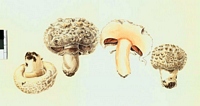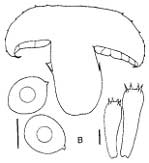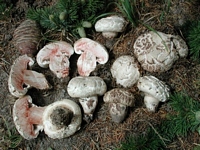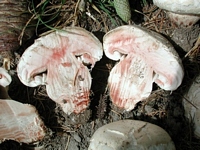|
 Agaricus bernardii Agaricus bernardii
SynonymsPsalliota bernardii
BiostatusPresent in region - Exotic
Images (click to enlarge)
Caption: Watercolour
Owner: G.M. Taylor | 
Caption: B, A. bernardii. Bars = 5 µm. | 
Caption: fruitbody showing reddening
Owner: J.A. Cooper | 
Caption: fruitbody showing reddening
Owner: J.A. Cooper | |
Article: Mitchell, A.D.; Walter, M. (1999). Species of Agaricus occurring in New Zealand. New Zealand Journal of Botany 37(4): 715-725 (http://www.rsnz.org/publish/abstracts.php).
Description: Pileus 60-200 mm diam., thick, fleshy, hemispherical
when young, finally broadly convex-applanate, ± centrally depressed, surface
scaly, scales sometimes become very pronounced during dehydration, whitish (N9.5)
when young, finally moderate brown (7.5YR 4/4), bruising reddish to strong reddish
orange (7.5R 6/10-5/12); margin thin, inrolled, edge broken with remnants of
veil; lamellae insertion free, thin, crowded, pale grey (5YR 8/1-8/2), when
young, finally brown to dark brown (5YR 4/4-3/2); edge pale and sterile; trama
parallel to irregular. Stipe 40-80 x 40-50 mm, central, solid, cylindrical,
base round to narrowing, surface smooth, white (N9.5) above annulus, moderate
brown (7.5YR 4/4) below annulus, bruising red to carmine-red (5R 5/12-3/12).
Annulus peronate, sometimes double, thin, white (N9.5) above, moderate brown
(7.5YR 4/4) below close to stem, surface smooth. Flesh quickly becoming red
to carmine-red (5R 5/ 12-3/12) with cutting or bruising; odour unpleasant, fish-like,
taste unpleasant. Schaffer's cross-reaction negative.
Basidia 4-spored, 14-25 x 4-7 µm, clavate
with sterigmata 4-5(-8) µm. Cheilocystidia 17-30 x 4-8 µm, broadly clavate to
cylindrical, hyaline, abundant. Basidiospores dark brown (5YR 3/2) in mass,
size (7.0-)7.9(-8.7) x (5.5-)6.1(-6.7) µm, elongation (1.1-)1.3(-l.4) µm, spherical
to globose, pale brown to brown (2.5YR 4/4-5YR 4/4) in water, refractive centre
(single droplets), apiculus lateral, gem-pore not visible:
Habitat: Gregarious in saline, sandy soils. Can form
large (1-10 m diam.) rings in tussock grassland/pasture. Not of high edible
quality.
Distribution: NEW ZEALAND Canterbury.
|